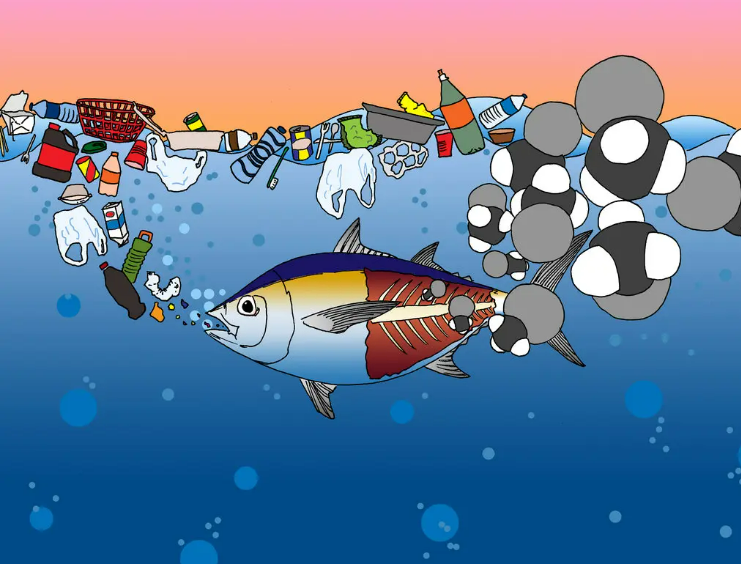我们通过发表论文来表彰学生 STEM 写作比赛的前八名获奖者。这是李薇薇的。

An Unexpected Dinner Guest: Marine Plastic Pollution Hides a Neurological Toxin in Our Food
In the mid-1950s, domesticated cats in Minamata, Japan, mysteriously began to convulse and fall into the bay. The people of Minamata took on similar symptoms shortly after, losing their ability to speak, move and think.
Chisso Corporation, a Japanese chemical company, had dumped more than 600 tons of mercury into the bay between 1932 and 1968 via their wastewater. Over the next several decades, 1,784 people living near the shore died of shared uncanny symptoms while doctors scrambled to uncover the cause.
The Minamata Bay disease characterizes long-term impairment of the central nervous system from methylmercury poisoning. Although government organizations worldwide have since limited the mercury that enters surface waters, this toxin has a new and powerful avenue to the human brain: marine plastic pollution.
Methylmercury journeys up the food chain from phytoplankton and zooplankton to fish and humans. Dr. Katlin Bowman, a research scientist at the University of California, Santa Cruz, explains that heavy metal toxins naturally adhere to plastics in the water, creating extremely concentrated “fish food bombs” of mercury. “Plastic has a negative charge and mercury has a positive charge. Opposites attract so the mercury sticks,” Dr. Bowman said.
According to Abigail Barrows, a marine research scientist from the College of the Atlantic, microplastics are even more concentrated in methylmercury as a result of their greater ratio of surface area to volume, trapping toxic particles in the many folds and tight spaces. Less than five millimeters in size, microplastics range from microbeads in personal care products to microfibers from clothing. “If microplastics increase the rate of methylmercury production, then microplastics in the environment could indirectly be increasing the amount of mercury that accumulates in fish,” Dr. Bowman said.
Two key characteristics worsen methylmercury’s impact: bioaccumulation and biomagnification. With bioaccumulation, “the longer the fish lives, it keeps eating mercury and doesn’t lose it, so it ends up concentrating very high levels of mercury in its tissues,” said Dr. Nicholas Fisher, a distinguished professor at the State University of New York Stony Brook. “The methylmercury also biomagnifies, meaning the concentration is higher in the predator than it is in the prey.” Predators at the top of the food chain have more than 100,000 times more methylmercury in their bodies compared to the surrounding water.
However, our focus should be on the plastic pollution issue rather than mercury discharge. Dr. Carl Lamborg, a research scientist at U.C. Santa Cruz, explains that while mercury naturally cycles through the environment, plastics serve as a magnet, prolonging its lifetime in the ocean and funneling it into the mouths of plankton and fish.
The Minamata Bay disaster has already spelled out the horrific effects of mercury poisoning in all of its nitty-gritty glory, but the 87,000 tons of plastic in the growing Great Pacific Garbage Patch ensures that the problem will only swell.
“The plastic produced is on trend to double in the next 20 years,” said Dr. Barrows. “So I think that’s where we need to focus on in terms of worrying about our environment.”
Works Cited
Albeck-Ripka, Livia. “The ‘Great Pacific Garbage Patch’ Is Ballooning, 87,000 Tons of Plastic and Counting.” The New York Times, 22 Mar. 2018.
“A Short Explanation of the Mercury Issue.” European Commission, 7 Dec. 2012.
Barboza et al. “Microplastics Cause Neurotoxicity, Oxidative Damage and Energy-Related Changes and Interact with the Bioaccumulation of Mercury in the European Seabass, Dicentrarchus Labrax (Linnaeus, 1758).” Aquatic Toxicology, Feb. 2018.
Barrows, Abigail. Marine Research Scientist, College of the Atlantic. Interview.
Bowman, Katlin. Postdoctoral Research Scholar, University of California Santa Cruz. Interview.
Fisher, Nicholas. Distinguished Professor, State University of New York Stony Brook. Interview.
Lamborg, Carl. Associate Professor, University of California Santa Cruz. Interview.
Liboiron, Max. “Plastics & Methylmercury.” Civic Laboratory for Environmental Action Research, 15 July 2017.
“Minamata Disease.” Boston University Sustainability.
NOAA. “What Are Microplastics?” National Ocean Service website, 13 Apr. 2016.
Winner, Cherie. “How Does Toxic Mercury Get into Fish?” Oceanus Magazine, 1 Oct. 2010.